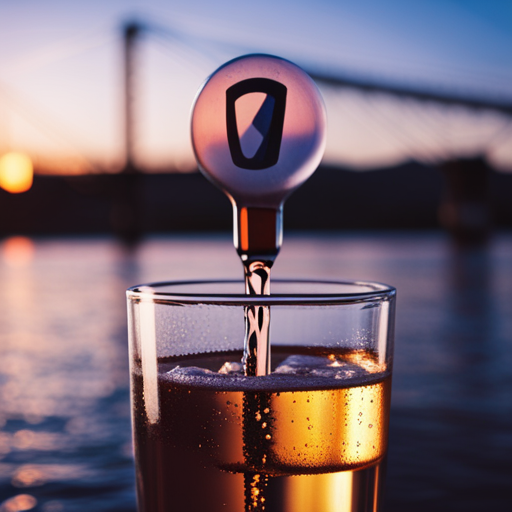Are you a fan of sparkling water? Do you choose it over soda as a healthier alternative? Well, you might want to think twice before taking that next sip. It turns out that some of your favorite sparkling water brands contain PFAS, a synthetic chemical that can cause a range of health issues and environmental problems.
In this article, we’ll explore the shocking truth about PFAS in sparkling water. We’ll reveal which brands have high levels of these harmful chemicals and which ones are safer to consume. Most importantly, we’ll give you the tools you need to make informed choices about what you drink and how you can reduce your exposure to PFAS.
So buckle up and get ready to learn the truth about what’s really in your sparkling water.
Key Takeaways
– PFAS, synthetic chemicals, have been found in some sparkling water brands and excessive exposure to these chemicals may lead to health issues.
– Long-term exposure to high levels of PFAS has been linked to hormonal disruptions, weakened immune systems, increased cholesterol levels, developmental issues in children, and increased risk of certain cancers.
– Consumers should choose brands that prioritize water quality testing and filtration to reduce PFAS exposure and some low PFAS sparkling water brands include Sparkling Ice, Spindrift, Sanpellegrino, Dasani, and Schweppes.
– Some states have set lower limits of 12 to 20 ppt for PFAS in drinking water and it is essential to stay informed about the latest recommendations from reputable health and environmental organizations to minimize PFAS exposure as much as possible.
PFAS and Health Risks
You should be aware that excessive exposure to PFAS, which are synthetic chemicals found in some sparkling water brands, can lead to health issues such as weakened immune systems, hormonal disruptions, developmental issues in children, and increased risk of certain cancers. PFAS have negative effects on the endocrine system, regulating hormones and leading to disruptions in hormone production. Even more, higher concentrations of PFAS can disrupt hormone production, leading to reduced testosterone levels in men.
Long-term exposure to high levels of PFAS has been linked to developmental issues in children, including delayed growth and learning disabilities. These chemicals can accumulate in the environment, especially in water sources, leading to possible contamination of drinking water. The carbonation process and high levels of PFAS in source water used for producing sparkling water may lead to a higher concentration of these chemicals in the final product.
Therefore, it’s essential to stay informed about PFAS levels in different brands of sparkling water and choose brands that prioritize water quality testing and filtration to reduce PFAS exposure.
Environmental Impact
Consider the negative impact on the environment caused by the presence of synthetic chemicals in some carbonated beverage brands. PFAS chemicals can persist in the environment, leading to water pollution and bioaccumulation. As a result, the production and consumption of high PFAS sparkling water brands can have far-reaching consequences for the environment.
To address this issue, PFAS regulation is needed to limit the use and production of these harmful chemicals. In addition, advancements in water filtration technology can help remove PFAS from source water used for carbonated beverages. By supporting brands that prioritize water quality testing and filtration, consumers can contribute to reducing the environmental impact of PFAS in sparkling water.
Low PFAS Brands
Take note of the low PFAS brands mentioned in the previous section to make informed choices when purchasing carbonated beverages. Sparkling Ice, Spindrift, Sanpellegrino, Dasani, and Schweppes are low PFAS sparkling water brands that prioritize water quality testing and filtration to reduce PFAS exposure. These brands provide refreshing and tasty sparkling water options without compromising your health.
On the other hand, brands to avoid include Perrier, La Croix, Canada Dry, Poland Spring, Bubly, Polar, and Topo Chico, which are high PFAS sparkling water brands. Excessive PFAS exposure may lead to health concerns such as hormonal disruptions, weakened immune systems, increased cholesterol levels, developmental issues in children, and increased risk of certain cancers.
By keeping yourself informed about the PFAS concentration in different brands and making conscious choices about the brands you consume, you can minimize your PFAS exposure and reduce the potential for adverse health effects.
Making Informed Choices
To make informed choices about the beverages you consume, it’s important to stay informed about the PFAS concentration in different brands. Prioritize brands that have made commitments to reducing PFAS levels in their products and have transparent information about their production processes.
Consumers concerned about their health should look for brands that have transparent information about their water sources and production processes. Brands that use reverse osmosis or activated carbon filtration systems can help reduce PFAS levels in their products, making them a safer option for consumption.
Choosing wisely can help reduce your exposure to harmful chemicals like PFAS. Prioritizing brands that prioritize water quality testing and filtration can help reduce the potential for adverse health effects. By staying informed and making conscious choices about the brands you consume, you can enjoy a refreshing sparkling water without worry.
Conclusion
So, now that you know the shocking truth about PFAS in sparkling water, what can you do to reduce your exposure?
First, check the labels of your favorite brands and opt for those with low or no detectable levels of PFAS. Some brands, like Spindrift, LaCroix, and Waterloo, have been found to have low levels of PFAS, while others, like Topo Chico and Polar, have higher levels.
But don’t stop there. You can also take action to reduce your overall exposure to PFAS by avoiding non-stick cookware, stain-resistant clothing, and other products that may contain these harmful chemicals.
It’s up to us as consumers to make informed choices and demand safer products for ourselves and our families. By staying informed and taking action, we can protect ourselves and our environment from the dangers of PFAS.
